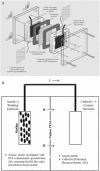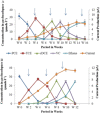Sustainable remediation: electrochemically assisted microbial dechlorination of tetrachloroethene-contaminated groundwater
- PMID: 24119162
- PMCID: PMC3896933
- DOI: 10.1111/1751-7915.12089
Sustainable remediation: electrochemically assisted microbial dechlorination of tetrachloroethene-contaminated groundwater
Abstract
Microbial electric systems (MESs) hold significant promise for the sustainable remediation of chlorinated solvents such as tetrachlorethene (perchloroethylene, PCE). Although the bio-electrochemical potential of some specific bacterial species such as Dehalcoccoides and Geobacteraceae have been exploited, this ability in other undefined microorganisms has not been extensively assessed. Hence, the focus of this study was to investigate indigenous and potentially bio-electrochemically active microorganisms in PCE-contaminated groundwater. Lab-scale MESs were fed with acetate and carbon electrode/PCE as electron donors and acceptors, respectively, under biostimulation (BS) and BS-bioaugmentation (BS-BA) regimes. Molecular analysis of the indigenous groundwater community identified mainly Spirochaetes, Firmicutes, Bacteroidetes, and γ and δ-Proteobacteria. Environmental scanning electron photomicrographs of the anode surfaces showed extensive indigenous microbial colonization under both regimes. This colonization and BS resulted in 100% dechlorination in both treatments with complete dechlorination occurring 4 weeks earlier in BS-BA samples and up to 11.5 μA of current being generated. The indigenous non-Dehalococcoides community was found to contribute significantly to electron transfer with ∼61% of the current generated due to their activities. This study therefore shows the potential of the indigenous non-Dehalococcoides bacterial community in bio-electrochemically reducing PCE that could prove to be a cost-effective and sustainable bioremediation practice.
© 2013 The Authors. Microbial Biotechnology published by John Wiley & Sons Ltd and Society for Applied Microbiology.
Figures




References
-
- ATSDR. 2007. Substances most frequently found in completed exposure pathways (CEPs) at hazardous waste Sites. United States Department of Health and Human Services, Agency for Toxic Substances & Disease Registry, CEP Report. [WWW document]. URL http://www.Atsdr.cdc.gov. Accessed on 11 February 2011.
-
- Aulenta F, Catervi A, Majone M, Panero S, Reale P, Rossetti S. Electron transfer from a solid-state electrode assisted by methyl viologen sustains efficient microbial reductive dechlorination of TCE. Environ Sci Technol. 2007;41:2554–2559. - PubMed
-
- Aulenta F, Canosa A, Majone M, Panero S, Reale P, Rossetti S. Trichloroethene dechlorination and H2 evolution are alternative biological pathways of electric charge utilization by a dechlorinating culture in a bio-electrochemical system. Environ Sci Technol. 2008;42:6185–6190. - PubMed
-
- Aulenta F, Canosa A, Roma LD, Reale P, Panero S, Rossetti S, Majone M. Influence of mediator immobilization on the electrochemically assisted microbial dechlorination of trichloroethene (TCE) and cis- dichloroethene (cis-DCE) J Chem Technol Biotechnol. 2009a;84:864–870.
-
- Aulenta F, Canosa A, Reale P, Rossetti S, Panero S, Majone M. Microbial reductive dechlorination of trichloroethene to ethene with electrodes serving as electron donors without the external addition of redox mediators. Biotechnol Bioeng. 2009b;103:85–91. - PubMed
Publication types
MeSH terms
Substances
Associated data
- Actions
- Actions
- Actions
- Actions
- Actions
- Actions
- Actions
- Actions
- Actions
- Actions
- Actions
- Actions
LinkOut - more resources
Full Text Sources
Other Literature Sources
Miscellaneous

